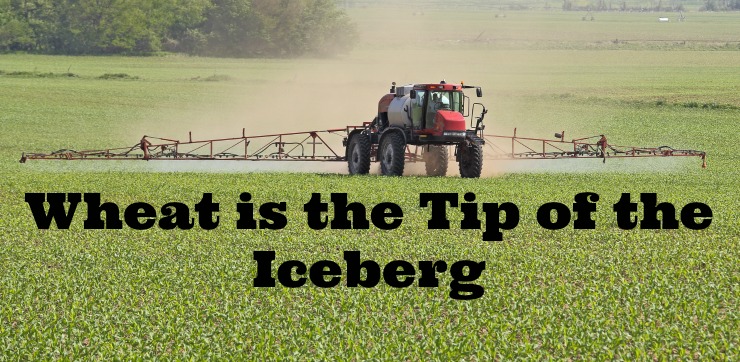
Pre-harvest application of herbicides as a (toxic) drying agent on wheat is
an established practice on many conventional farms. The method was
first suggested as early as 1980, becoming routine in North America over
the past 15 years or so. Use is also widespread in the UK.
Applying herbicides like Roundup 7-10 days before harvest is viewed
as especially helpful for wheat that ripens unevenly, a common
occurrence. It is also considered a helpful tool to initiate an earlier
harvest when weather conditions threaten plant viability. Other benefits
are earlier ripening for earlier replanting and reducing the green
material in the field. This puts less strain on farm machinery during
harvest.
Farmers euphemistically call the practice “desiccation”. When used
during wheat harvest, it can result in slightly greater yield by
triggering plants to release more seeds.
The result? Most non-organic wheat in North America is now
contaminated with glyphosate, the active ingredient in Roundup and
similar herbicides.
WHO: Glyphosate a Probable Carcinogen
A March 2015 report by the World Health Organization identified glyphosate as a probable human carcinogen. Several EU countries have banned it as a result with more in the works.
However, in North America, glyphosate use shockingly continues to remain a popular farming tool.
And, as it turns out, use of Roundup as a drying agent on wheat prior to harvest is just the tip of the iceberg.
Dozens of other food crops are subjected to glyphosate dousing prior to harvest as well.
But Wait! Isn’t Roundup Just for GMO Crops?
It is well known that Roundup is sprayed directly on GMO crops like
corn and soy because they are genetically engineered to withstand the
toxic onslaught without withering. So much Roundup is used on GMO crops,
in fact, that herbicide-resistant “superweeds” are now a huge problem
little more than a decade later (1).
“If Roundup kills plants that aren’t genetically modified to resist it, then why use it on nonGMO crops?”
“Wouldn’t glyphosate kill a nonGMO crop?”
“Why would a farmer do this?”
Indeed, these common consumer questions indicate the ultimate irony
of using Roundup for desiccation purposes on a food crop producing farm.
Killing the crop and/or the greenery around it is actually the whole
idea. For crops like wheat, it evens up the field, allows for an earlier
harvest, protects machinery and/or increases profit.
The bottom line?
Pre-harvest treatment of crops with glyphosate helps farmers to harvest their crops more efficiently and at less cost (2)
Crazy as it may seem, Roundup is used everywhere in the North
American conventional food supply and not just on GMO crops or to kill
weeds!
Glyphosate is applied directly to dozens of nonGMO food crops, in many cases, right before they are harvested.
This is the worst possible time to apply a herbicide because it causes
the glyphosate to be absorbed into the food crop directly. In other
words, the glyphosate can’t be washed off later as it has become part of
the food. This toxin will then be ingested by those who consume it
either directly as a “whole food” or via processed foods that contain it
as an ingredient.
According to the Cornucopia Institute:
Ubiquitous in food production, glyphosate is used not just with row crops like corn, soybeans and wheat but also a range of fruits, nuts and veggies. Even spinach growers use glyphosate (3).
No comments:
Post a Comment